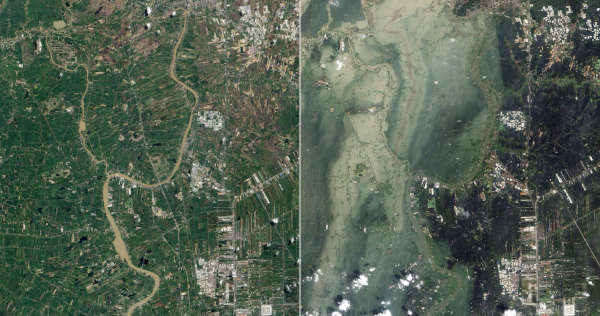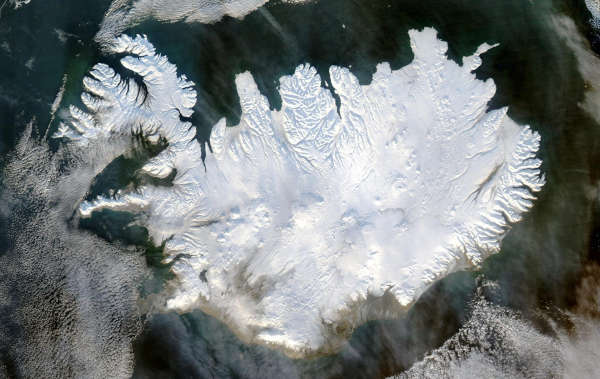A control moment gyroscope (CMG) is an actuator technology that is used to manoeuvre satellites, adding new levels of agility that can unlock additional capabilities in orbit.
This article is an introduction to CMG manufacturer Veoware Space, a paying participant in the satsearch membership program, and was produced in collaboration with the company.
Control moment gyroscopes (CMGs) are actuators used for satellite pointing control purposes, such as refocusing of mirrors, scanning mechanisms, optical path adjustments, and also for a range of mechanical activities in space exploration. They can operate complementary to, or in the same manner as, some functions of reaction wheels, attitude control thrusters, magnetorquers, and other similar sub-systems.
In particular, CMGs are increasingly being seen as a highly suitable actuator technology for Earth Observation (EO) satellites, as such systems have demanding pointing requirements. In larger systems, the type and quality of the imagery data collected can also depend on the agility of the satellite itself.
In addition, across all form factors, enhanced agility allows satellites to access off-nadir angles and collect imagery faster than simply waiting until the next available pass. Agility offers more flexibility on collection planning, allows shooting between clouds, and can shorten the time between imagery request and delivery.
As a result, greater agility is opening up new business models for satellite operators, such as the development of more advanced and efficient EO services or the creation of new remote sensing systems based on established optical payloads.
In this article, we provide an overview of CMG manufacturer Veoware Space and give some examples of past and current work in this area.
Introducing Veoware Space
Veoware Space has offices in the United Kingdom and in Belgium, with the majority of the technical development conducted at the office in Belgium. The company was founded in 2016 and has since shown significant growth in the Attitude Determination and Control System (ADCS) sector.
In 2021 Veoware secured new seed funding and doubled the team headcount. Today Veoware Space’s portfolio focuses on all aspects of attitude control systems and support services; from reviewing new ADCS requirements through simulation and design, to the production and ongoing support of systems in-flight.
In particular, the company specializes in developing miniaturized control moment gyroscopes (CMGs) for small satellite applications, designed as scalable and modular systems that can provide highly agile actuation capabilities.
This core technology was developed under a number of projects with the European Space Agency (ESA) and multiple flights to orbit of the systems are scheduled in 2022. The products are currently undergoing technology environmental testing, performed together with ESA, as part of the final mission development stage.
About control moment gyroscopes (CMGs)
A CMG typically consists of a spinning flywheel and one or more gimbals that are motorized. The gimbals are used to tilt the angular momentum of the rotor and the change in the angular momentum causes a gyroscopic torque which can rotate the satellite or spacecraft.
CMGs can offer as much as forty times (40x) the torque, for the same input momentum, of traditional reaction wheels, roughly halving the power requirements.
Reaction wheels require a greater level of power in order to change momentum, whereas CMGs are able to accelerate or decelerate both anti-clockwise and clockwise more efficiently. A CMG’s flywheel runs at constant speed while only the gimbal turns, requiring less power in order to produce altered output torque.
However, when using a CMG it is important to mitigate the impact of singularities, which cause an additional level of complexity in the control algorithms that are similar to the zero-crossing avoidance algorithms for reaction wheels.
Singularities are situations in which no output torque is produced by the system due to all individual CMG torque output vectors being perpendicular to the desired torque direction (i.e. becoming coplanar).
There are however multiple techniques to avoid singularities. For example, Veoware Space utilizes an internal CMG gimbal management solution that computes the distance from singularities and optimizes its trajectory to always increase such distance.
The applications of CMGs
CMGs can bring a number of useful capabilities to small satellites. Increased agility is becoming more important for satellite manufacturers and integrators looking to maximize their payload or other sub-system investments.
For example, an Earth Observation satellite equipped with a CMG can start collecting a whole new sort of imagery than just simply staying nadir-pointed during collection. This can include, but is not limited to:
- Multi-point target imaging to collect sites around the world such as; cities, harbors, power plants, areas of transit (e.g. The Channel), airports, etc.,
- Multi-strip target imaging to increase the swath by an n-multiple of strips imaged next to each other and offering an n-times higher amount of km² mapped per pass. This is particularly important for floods and emergency response where km² needs to be imaged and delivered as fast as possible,
- Cross-track strip imaging to monitor country coastlines, or rivers, and
- Stereo or tri-look imaging to create 3D images of the zone of interest or create super-resolution pictures by merging images (sub-pixel resolution).
In addition, an EO constellation also equipped with optical inter-satellite communication links will be able to re-orient the satellite either towards ground or in-orbit terminals in order to rapidly downlink high volumes of data. Using CMGs, the spacecraft could save the use of gimbaled laser terminals, hence saving mass and complexity.
CMGs are typically heavier than reaction wheels but can be easily used alongside them, with control switching between each system as needed.
The required mass budget makes them particularly suitable for larger satellites, which also often have greater requirements for precision pointing and attitude control torque.
The Veoware Space MiniCMG for example is suitable for satellites above 250 kg and the Veoware Space MicroCMG is suitable for 50 – 250 kg satellites.
Veoware Space’s CMGs are also designed to be adaptable to different mission requirements by changing the configuration in which they are accommodated on-board. Basically, how many CMGs are accommodated, and at what angles they are fixed, can maximize the agility around some axes compared to others. This enables more efficient access to off-nadir angles in order to increase the chances of collecting the desired target.
Veoware can also calibrate the CMGs with orientations to offer different preferential directions, and the systems feature microvibration mitigation to enable high pointing stability.
In addition, various readymade libraries are provided for the interface software so that torque requirements from the satellite platform can be interpreted by the CMG cluster and the gimbal position adjusted accordingly.
Versatility through modularity
Modularity is a key feature of Veoware’s CMG technology, and also provides an inherent redundancy for the actuator system. The Veoware Space MiniCMG and MicroCMG can be used in clusters in order to meet a wide variety of torque requirements, with the number of CMGs required for a specific mission determined as part of the project design phase.
Module clustering is enabled from 4 to 16 CMGs, with an ideal recommendation of 4 CMGs for basic function. For example, in a 6 CMG cluster, 4 CMGs are used for roll and pitch, and 2 CMGs for yaw manoeuvring of the satellite.
Veoware Space’s CMG clusters can also be used in combination with a cluster of reaction wheels to boost agility and redundancy of the actuator system of the satellite. For example, a cluster of 4 reaction wheels from another company can be integrated alongside a cluster of 2 Veoware CMGs.
The clustering approach provides flexibility in terms of positioning CMGs in the satellite structure. For example, if there are space constraints restricting the ability to place CMGs next to each other, they can be situated in another location anywhere else in the satellite, without the need for a change in the design.
Since the design is fixed and the requirements are met through the modularity of CMGs, the lead time for manufacturing can be significantly reduced.
In addition, the product development process is also simplified as it will include reviewing the requirements and deciding on the number of clusters first, followed by production and delivery of the individual systems.
Testing and qualification
An effective ADCS requires careful integration into the satellite bus in order for the output torque to position the system as needed. This requires thorough testing before, during, and after integration.
In order to ensure a successful CMG integration, Veoware assesses momentum effects, torque microvibrations and jitter, and bias and noise of the mission requirements as part of the design review process.
The team also provides simulated power, momentum, and torque profiles based on the pointing requirements in order to feed into mission scenario design or satellite service economics. The mathematical model of the design is also provided to the customers for further simulations and testing as required.
Mass, volume, and interface recommendations for different actuators solutions are also offered to help ensure more seamless compatibility and interoperability with other sub-systems.
Conclusion
A more agile satellite has the potential to create new business opportunities in a number of downstream applications. Enabling the satellite to be agile will also have an impact on access to the target area, thereby reducing the required overhead time for coverage.
For a satellite constellation, if all of the satellites have more agility, the operator may not need as many of them to provide the same services, contributing to the sustainable use of space and debris mitigation.
CMGs could be a very suitable choice of actuator technology for the attitude control requirements of a highly agile small satellite, given the low power requirements compared to reaction wheels.
As discussed, systems such as Veoware Space’s miniaturized CMG technology, in modular forms, provides scalable solutions for satellite manufacturers that can open up new opportunities.
To find out more about Veoware Space and view further details on the company’s control moment gyroscope (CMG) portfolio, please see their satsearch supplier hub here.



